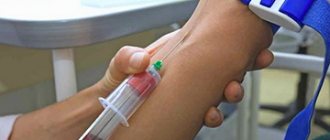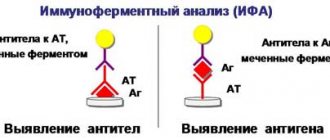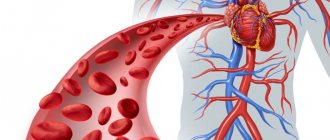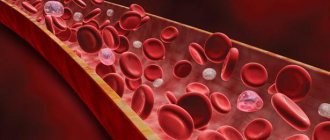Blood test for anemia: causes, determination of anemia by blood test
Why does anemia occur, and what are the causes of its occurrence in adult men and women?
What are the laboratory signs of this condition, and what blood test for anemia should be taken first: a biochemical or general blood test? Anemia is usually translated as “anemia,” but if we translate this word literally, then it is “bloodlessness,” since the prefixes “a” and “an” are negative. Of course, one hundred percent blood anemia is impossible, but doctors of various specialties often encounter clinical and laboratory manifestations of anemia. These common symptoms include dizziness, ringing in the ears, pallor, shortness of breath, and decreased exercise tolerance.
Causes of anemia syndrome
The number of reasons leading to the development of anemia is very large. They can be divided into external and internal. External factors include the influence of environmental factors, nutrition, and internal factors include diseases and developmental abnormalities.
External reasons
Since a person receives iron and various proteins that form hemoglobin from food, iron deficiency, fasting, and lack of vitamins such as ascorbic and folic acid lead to anemia. Vitamin B12, or cyanocobalamin, plays a special role. Its deficiency causes severe anemia, which was previously called malignant or pernicious anemia.
External factors also include the use of various chemicals, occupational chronic intoxication and acute poisoning, and the influence of certain medications. These are arsenic and benzene, drugs such as cytostatics, some antibacterial drugs, hormones, thyreostatics. Thyreostatics include drugs that reduce the production of hormones by the thyroid gland. Also, some anticonvulsants can cause anemia syndrome with long-term use.
Of course, the simplest cause of anemia is bleeding. In the case of acute blood loss, the patient is threatened not so much by anemia as by hemorrhagic shock, but with a long period of recovery from major blood loss, it is quite possible to talk about the development of anemia. Much more often, small but regular blood loss, which is chronic, leads to anemia.
Many people believe that donation can lead to anemia. Of course, this is true, but according to existing rules, the frequency of blood donations from donors is strictly regulated. Thus, the donor cannot repeat the procedure if 60 days, or two months, have not passed since the previous donation. In addition, there is a limitation of the other plan. During a calendar year, a man can donate blood no more than 5 times, and a woman no more than 4 times.
Internal reasons
A large group of internal causes of anemia syndrome are hereditary or genetic diseases. These are defects in the structure of hemoglobin that cause thalassemia and sickle cell anemia. Also, disruption of the functioning of enzymes in erythrocytes, or disturbances in the formation of the cellular skeleton, leads to anemia, defects of erythrocytes, which are manifested by changes in their size and shape, for example, Minkowski-Choffard disease. With this disease, red blood cells cease to resemble biconcave discs and become like balls.
Impaired absorption of various substances in the intestine can also lead to chronic anemia, the most common diseases being glomerulonephritis and tuberculosis, chronic viral hepatitis and cirrhosis. All diseases that lead to bleeding can also be attributed to predisposing factors for the development of anemia. These are malignant neoplasms and stomach ulcers, ulcerative colitis and Crohn's disease.
Finally, there are physiological factors for the occurrence of anemia, for example, anemia in women can often occur against the background of long and heavy periods. Of course, nature prevents severe blood loss, since menstrual blood is much poorer and is not blood in the full sense of the word. This is nothing more than the inner lining of the uterus, or endometrium, which has become unnecessary.
What to do if you have iron deficiency anemia?
First, you need to understand an important thing: if anemia has already developed, then the body has a serious deficiency of iron and it is impossible to replenish it with food alone.
In this case, you should definitely consult a doctor. Take medications containing iron: In case of severe anemia, chronic diseases or poor tolerance, iron supplements are administered intravenously. But it is not advisable to administer iron preparations intramuscularly, since in this case the likelihood of complications is very high.
IMPORTANT! Iron supplements need to be taken not only until hemoglobin normalizes, but also for at least two additional months to replenish tissue reserves as well.
You can hear from many people that iron supplements are poorly tolerated. Yes this is true. Sometimes they lead to the development of side effects from the gastrointestinal tract: constipation or diarrhea, nausea, abdominal pain, metallic taste in the mouth.
Iron supplements can turn stool black - this is a normal reaction, you should not be alarmed.
What does anemia “consist” of?
Human blood is a unique liquid tissue that has many different functions, from transport to protective. Most of the various substances that it contains, such as bilirubin, proteins, enzymes, electrolytes, are molecules and can be examined by performing a biochemical blood test.
But at the same time, the main and most important function of this fluid is respiratory. Blood transports oxygen from the lungs to all organs and tissues, and releases carbon dioxide back for gas exchange. She does this through the respiratory pigment hemoglobin, which is found in red blood cells - erythrocytes. Therefore, the transport of oxygen and carbon dioxide falls entirely within the competence of red blood cells.
All of the listed symptoms associated with oxygen deficiency refer to the pathology of red blood cells or hemoglobin. Therefore, laboratory signs of any anemia will be various conditions that lead either to a decrease in hemoglobin concentration or to a decrease in the number of red blood cells in a standard volume of blood. Accordingly, these two processes lead to a decrease in the hematocrit analysis, which we wrote about in the article “Hematocrit (HCT) in blood analysis,” this indicator reflects the ratio of the cellular composition of the blood to its liquid part, or plasma.
B12 deficiency anemia.
In addition to iron deficiency anemia, there is another anemia - B12 deficiency anemia. This anemia is treated completely differently. Therefore, it is not advisable to blindly buy and drink drugs to treat anemia. First of all, you need to establish the cause and type of anemia. In addition, self-medication can “blur the picture” and subsequently make it difficult to make a correct diagnosis.
If in a blood test, in addition to low levels of hemoglobin, red blood cells and hematocrit, we see an increase in the color index or an increase in MCH and MCV, then most likely we are talking about B12-deficiency anemia.
Vitamin B12 is necessary for the maturation of red blood cells. Its deficiency leads to the appearance of large blood cells, which are quickly destroyed.
The causes may be gastrointestinal diseases, impaired production of antibodies that interfere with the absorption of this vitamin in the stomach. With B12 deficiency anemia, damage to the nervous system often develops, tingling appears in the hands and feet, sensitivity in the legs and arms decreases, muscle spasms and muscle weakness occur.
MORE ABOUT: Why do breasts hurt after menstruation?
In this case, in addition to a general blood test, you need to take a test for vitamin B12 (cyanocobalamin) and homocysteine. With this disease, B12 levels will be significantly reduced, and homocysteine, on the contrary, will be increased. In addition, the level of leukocytes and platelets may be reduced in the analysis.
General blood test data
Nowadays, when tests for anemia are performed automatically, using biochemical analyzers, it has become possible to study a large number of different erythrocyte indices, which can help the doctor in diagnosing anemia. We will not go into details, and will name only the most important indicators that will help determine anemia:
- the size of red blood cells, or the average diameter of red blood cells. There are varieties of anemia, which are accompanied by both an increase in the diameter of blood cells and a decrease in their size, or normal size.
Normal sizes include a range of 80 to 100 cubic micrometers for each blood cell. Accordingly, anemia can also be normocytic, microcytic, and macrocytic;
- color index, CPU. This value shows the “brightness” of the color of red blood cells and depends on their saturation with the respiratory pigment hemoglobin.
If the color index is less than 0.85, then this indicates a decrease in hemoglobin in red blood cells, and corresponds to the amount of hemoglobin less than 30 g per deciliter, g/dl. In this case we will talk about hypochromic anemia. At the same time, there are both normochromic and hyperchromic variants of anemia, in which the color index will fluctuate around one, and the average hemoglobin content in erythrocytes will also be normal, from 30 to 38 g/dl;
- Also, poikilocytosis, or the appearance of various non-standard red blood cells of various shapes and sizes, can be detected in red blood.
This symptom suggests that in conditions of iron deficiency, which occurs with iron deficiency anemia, red blood cells are produced in the red bone marrow that are far from the standard, made “from what was available”;
- the presence of an increased number of reticulocytes (more than 1%).
Reticulocytes are young and immature red blood cells in which the primary nucleus has not yet been completely removed, and this structure resembles a network, hence the name. An increase in the number of reticulocytes indicates a lack of red blood, or an increased rate of destruction of these cells. As a rule, altered and defective red blood cells are destroyed at an increased rate, for example, with the same hereditary Minkowski-Choffard microspherocytosis.
- Also, in a general blood test, hematocrit is determined, which indirectly indicates the development of anemia.
When you donate blood, it is centrifuged to separate a heavy layer of red blood at the bottom and a lighter layer of plasma at the top. In men, the normal hematocrit level should not be less than 0.4, and in women it should not be less than 0.36. When this value decreases, anemia syndrome may occur.
What substances and their changes characteristic of anemia can be detected in a biochemical blood test?
Assessment of the quality of treatment of iron deficiency anemia based on test results
Response to iron tablet therapy is the final evidence for diagnosing iron deficiency, but the primary cause of anemia must be determined first; response to iron treatment does not eliminate the need to determine the underlying cause of the disease.
- With adequate treatment, an increase in the level of reticulocytes in iron deficiency anemia occurs in 3 - 7 days with a peak of 8% to 10% (2-4 times compared to the baseline) on the 5th - 10th day; the rise is proportional to the severity of anemia.
- Successful treatment of iron deficiency anemia is accompanied by an increase in hemoglobin levels - an average value of 0.25 - 0.4 g / dl / day and hematocrit - an average value = 1% per day, during the first 7 - 10 days; subsequently, hemoglobin increases from 0.1 g/dL/day to 11 g/dL (or 2 g/dL) over 3 to 4 weeks.
- The hemoglobin level during the treatment of iron deficiency anemia should be half corrected in 3 weeks and completely returned to normal in 8 weeks. In elderly patients, it may take 1 month for hemoglobin in the blood to increase by 1 g/dL, while in younger patients, during this time, hemoglobin reaches 3 g/dL and hematocrit reaches 10%.
Treatment failures may be due to misdiagnosis, coexistence of deficiencies (folic acid, vitamin B12, thyroid hormones), mixed conditions (lead poisoning, bleeding, and liver or kidney disease).
Blood chemistry
Biochemical research involves determining:
- the concentration of iron in the blood serum - this indicator is called serum iron.
If total serum iron in women is less than 9, and in men less than 11.6 micromol per liter, then we can talk about iron deficiency anemia.
- The concentration of a special protein called ferritin is determined, and it is able to transport iron in a bound state.
Determining ferritin reliably shows how much stored or deposited iron exists in the body, and by determining ferritin, the doctor assesses the supply of iron in the blood. In adult women, the ferritin level should not be below 10 micrograms per liter, and in men - below 20. Moreover, a decrease in the ferritin value indicates only two conditions: IDA, or iron deficiency anemia, and an intestinal disease called celiac disease.
- finally, the ability of blood serum to bind iron (TIB, total iron-binding capacity of serum) is examined; usually in anemia it is increased if we are talking about iron deficiency. Normally it ranges from 16 to 54 (average 31.2)
Determining ferritin reliably shows how much stored or deposited iron exists in the body, and determining levitin assesses the supply of iron in the blood. Research on this protein is very important. After all, in adult men and women, the level of ferritin in women should not be lower than 10 micrograms per liter, and in men it is less than 20. Moreover, a decrease in the value of ferritin indicates only two conditions: iron deficiency associated with the development of iron, and intestinal diseases, which called celiac disease or spore.
Causes of anemia
The causes of anemia are very diverse; accordingly, there are many types of it. Anemia can be caused by a lack of substances necessary for the production of hemoglobin, impaired maturation of red blood cells in the bone marrow, acute massive or prolonged blood loss, destruction of red blood cells under the influence of poisons or other unfavorable factors, hereditary diseases and other, more rare, causes.
Anemia is a condition in which the number of red blood cells and/or hemoglobin in them is reduced in the blood. This deficiency affects oxygen transport function. This is one of the main results of blood circulation - it delivers O2 molecules to tissues through arteries and, thanks to venous outflow, removes waste materials, including carbon dioxide. The main gas exchange occurs in the alveoli - the final formations of the bronchial tree. This is the part of the respiratory system where the blood gives off some gases and takes away others. The insufficiency of this process leads to hypoxia - a reduced supply of oxygen to the tissues. This affects all processes in the body, the condition of tissues and cellular mechanisms. Without the presence of oxygen, chemical reactions do not take place and energy exchange does not occur.
Externally, this is manifested by various clinical signs:
- pallor;
- weakness;
- increased heart rate and breathing - the body tries to compensate for the lack of oxygen;
- possibility of loss of consciousness;
- decreased performance; flashing “spots” before the eyes;
- dizziness;
- noise in ears;
- irritability;
- dyspnea.
These signs are a reason to go to a medical center for testing. Anemia is often a manifestation of pathology, since in itself, most often, it is a symptom. A full examination will reveal the cause of the condition and allow effective treatment to begin.
Significant losses of iron by the body can lead to the development of iron deficiency anemia, a pathological condition characterized by a decrease in the amount of hemoglobin in the blood. Prevention of anemia... Iron deficiency anemia is usually accompanied by the following symptoms: fatigue, constant weakness and decreased performance, pale skin, dry hair, split nails. How to eliminate iron deficiency in the blood? Taking iron supplements is an important measure in preventing anemia. Iron is one of the microelements vital to our body. Why does the body need iron? Iron deficiency in the body can cause the development of iron deficiency anemia. How can you eliminate iron deficiency in the blood? According to WHO1, in 21 of the 41 countries for which data are available, more than one third of girls aged 15–19 years suffer from anemia. What complications can arise from iron deficiency? Regular physical activity increases the body's need for iron. Why does the body need iron? "Ferrohematogen" is recommended as a dietary supplement to food as an additional source of iron, vitamins C, B6, B9 and copper. Find out the cost...
Lack of iron can cause many problems, from fatigue and hair loss to anemia. Millions of people are deficient in this trace element and don’t even know it. How to recognize iron deficiency anemia and take timely measures? Is it possible to cope with it without serious treatment? How to protect yourself and your child? You will learn about all this from the article.
Examinations prescribed for suspected anemia
Laboratory examinations are carried out to give an accurate conclusion, identify the type of anemia, and provide adequate therapy. Tests prescribed:
- general (clinical) blood test;
- biochemical analysis.
The results of laboratory examinations provide a clear picture of these basic values.
A general blood test to diagnose anemia is taken from a finger prick. It is advisable to carry out the procedure in the morning, on an empty stomach.
Examining the UAC data, the following is established:
- total number of red blood cells in the blood;
- the ratio of the volume and diameter of red blood cells, their compliance with the norm;
- number of reticulocytes (precursor cells);
- hemoglobin level in red blood cells (color indicator);
- ratio of types of leukocytes, platelets;
- determination of hematocrit number.
The values of these indicators help to determine the cause of the decrease in hemoglobin in the blood.
A biochemical study is carried out if the hemogram reveals a low hemoglobin value. Use it to install:
- quantitative value of iron in serum;
- transferrin level;
- serum binding capacity;
- the amount of ferritin.
These data provide the most complete picture of the nature of anemia and the characteristics of its course.
Blood for biochemical research is taken from a vein.
Modern methods for diagnosing anemia
To diagnose anemia, laboratory and instrumental research methods are used. For proper treatment, it is important to determine not only the fact of anemia and its type, but also the cause of this condition. It is better to detect the disease in the early stages of the process and do this using a variety of diagnostic methods. A complete picture of the state of the body gives a more complete understanding of the pathology. Only after a quality examination can effective treatment be prescribed.
The main method for diagnosing anemia is a complete blood count. with its help you can determine the number of red blood cells and hemoglobin, their ratio, color index, hematocrit, red blood cell diameter and other indicators. Sometimes, other indicators of a general blood test - the levels of other blood cells, ESR - can tell about the cause of the pathology. This test is performed first if anemia is suspected. Depending on its results, other diagnostic methods are prescribed.
A biochemical blood test will determine the level of serum iron, proteins that carry it, and the amount of vitamins B12 and B9. It is the biochemical analysis that helps to calculate the level of bilirubin and its fractions. thus, this manipulation is required to clarify the type of anemia. The analysis allows you to evaluate most processes in the body and provides comprehensive information about the functioning of internal organs.
The study of free protoporphyrin in erythrocytes determines the ability of erythrocytes to carry oxygen and allows us to determine the causes of anemia. Impaired heme binding is observed during acute intoxication and can be detected using this technique.
Bone marrow puncture analysis shows the presence of blasts, the precursors of blood cells. Diagnostics are used to confirm or rule out aplastic anemia. In addition, the levels of other missing cells need to be corrected. The study is combined with other diagnostic methods. Early initiation of treatment improves the prognosis for the patient and is only possible after a quality diagnosis.
A study of the acidity of gastric juice (pH-metry) is necessary to diagnose iron deficiency anemia. It is necessary to determine why the absorption of iron in the intestine is impaired and for this purpose this diagnosis is carried out. Increased production of gastric juice negatively affects other functions of the body, leads to chronic changes in the mucous membrane and causes secondary disorders.
The presence of parasites in the body leads to increased consumption of most useful substances and can provoke the occurrence of anemia. Their searches are also included in the anemia diagnostic program. It is worms that can provoke the development of megaloblastic, iron deficiency anemia. In addition, parasitic infection negatively affects other organs and systems, leading to chronic impairment of many functions.
Examination of stool for occult blood allows one to determine blood loss, due to which posthemorrhagic anemia occurs. Also, blood loss is a sign of gastrointestinal pathology that needs to be detected and treated. If you delay in finding the cause of anemia, the disease can progress, and the later the stage of the process, the more difficult it is to treat.
X-ray and endoscopic examination are necessary to detect the source of bleeding that led to anemia. This examination allows you to find pathology that needs to be corrected not only to treat anemia, but also for the full health of the body.
Main blood test indicators and their values indicating anemia
At the initial stage, to determine the presence of any anemia, the main indicators of the blood test are compared with reference values. The main values of the studied quantities are presented in the table:
| Patients | Hemoglobin, g/l (HB) | Red blood cells, million/µl (RBC) | Color index | Reticulocytes, % (RTC) |
| Men | 130 – 160 | 3,8 – 5,6 | 0,83 – 1,05 | 5,1 – 18,0 |
| Women | 120 – 140 | 3,7 – 5,3 | 5,0 – 17,0 | |
| Teenagers (14-18 years old) | 125 – 145 | 3,7 – 5,2 | 0,9 – 1,0 | 4,8 – 18,0 |
| Children (10-14) | 120 – 140 | 3,8 – 5,0 | 4,8 – 18,0 | |
| Children (5-10) | 110 – 135 | 3,9 – 5,1 | 4,8 – 18,0 |
Hemoglobin level
This is the main coloring substance that is part of red blood cells, which is responsible for the transfer of oxygen. A reduced hemoglobin component indicates the presence of anemia of various etiologies.
Based on the indicators of quantitative deviation of hemoglobin from the reference values, the nature of anemia is identified according to the degree of intensity:
- light – hemoglobin content from 110-90 g/l;
- average – from 90-70 g/l;
- heavy – less than 70 g/l.
Other indicators also help determine the nature and possible causes of anemia.
Red blood cells
Red anucleate blood cells that are disc-shaped. Due to their biconvex shape, red blood cells can deform to accommodate narrow capillaries. Red blood cells deliver oxygen from the lungs to all tissues and take away carbon dioxide. Low levels of these cells characterize any type of anemia.
Reticulocytes
These cells are an immature form of red blood cells. They are detected in the bone marrow and are found in some quantities in the peripheral blood. An increase in the proportion of reticulocytes indicates the destruction of red blood cells, which indicates the progression of anemia. The calculation is carried out as a percentage of all red blood cells. The value of reticulocytes helps to assess the severity of the disease.
Color index
This indicator is needed to determine the degree of hemoglobin saturation of blood cells (erythrocytes). If it is below normal, this may indicate the presence of anemia. Based on the CPU value, they are distinguished:
- hypochromic anemia (less than 0.8);
- normochromic anemia (0.8-1.05);
- hyperchromic anemia (over 1.05).
This data helps to identify the type of disease. A high color index indicates folate deficiency and B12 anemia. A normal CP value occurs in acute posthemorrhagic anemia. A reduced rate indicates iron deficiency.
How to eat with iron deficiency anemia?
It is worth remembering that if iron deficiency anemia already exists, then products alone will not be able to cure it. This requires taking medications. But for prevention they are quite suitable. By the way, there is almost no iron in apples. They turn brown when cut not because iron oxides are formed in them, but for a completely different reason.
MORE ABOUT: Ambrobene solution for inhalation - instructions for use
A lot of iron is contained in such products as: pork and beef liver; beef; hazelnuts; cereals; fresh mushrooms; millet cereal; sea cabbage; prunes; dried apricots; raisin; dried apricots; cherry; chicken egg; mackerel, etc.
Please note: more iron is absorbed from meat products (20%) than from plant products (5-10%). And the red color of the product does not at all guarantee a high iron content.
Tests for transferrin and ferritin
For a more accurate diagnosis of anemia, especially if iron deficiency is suspected, a biochemical blood test is often performed, which determines important characteristics:
Level of iron protein (ferritin) in the blood
The main role of this protein complex is to store and release iron for cells. By measuring the level of this protein, you can indirectly measure the amount of iron that is stored in the body. The normal ferritin content is 20 – 250 µg/l (men), 10 – 120 µg/l (women). Low levels indicate iron deficiency anemia.
Transferrin content
The purpose of this protein is to transport iron to the right place. Violation of transferrin levels leads to a lack of the element. The amount of incoming iron may be sufficient. This indicator reveals the activity of serum to bind iron. Normal protein level is 2.0-4.0 g/l. An increase in the amount may indicate iron deficiency anemia. A reduced level is characteristic of aplastic and hypoplastic anemia.
Testing for transferrin requires special equipment and certain tests, which are not always available.
In certain cases, the iron-binding ability of serum is determined, which shows the ability of blood to bind iron. When diagnosing anemia, the latent value of the iron-binding indicator is determined. The norm is 20-63 µmol/l.
Interpretation and norms of a general clinical blood test in adults
When studying a blood test from a finger, pay attention to the level and quantity of the following formed elements:
- red blood cells;
- hemoglobin;
- hematocrit;
- reticulocytes;
- average amount and % concentration of hemoglobin in red blood cells;
- leukocytes;
- platelets.
In addition, ESR (erythrocyte sedimentation rate), prothrombin time and color index are calculated.
When presenting the test results to the doctor, the laboratory assistant describes in detail the leukocyte formula, which includes values for six types of leukocytes: eosinophils, lymphocytes, monocytes, band neutrophils, segmented neutrophils.
Table No. 1 presents the norms of general blood test indicators in women and men.
Table No. 1
| Analysis indicators | As indicated in the laboratory | Normal for women | Normal for men |
| Red blood cells (× 10x12/l) | R.B.C. | 3,6-4,6 | 4,1-5,2 |
| Average erythrocyte volume (fl or µm3) | MCV | 82-98 | 81-95 |
| Hemoglobin (g/l) | HGB | 122-138 | 128-150 |
| Average HGB level in erythrocyte (pg) | MCH | 26-32 | |
| Color indicator | CPU | 0,8-1,2 | |
| Hematocrit (in % ratio) | HCT | 35-44 | 40-50 |
| Platelets (× 10x9/l) | PLT | 178-318 | |
| Average concentration of red blood cells in hemoglobin (%) | MCHC | 31-38 | |
| Reticulocytes (%) | RET | 0,4-1,3 | |
| Leukocytes (× 10x9/l) | WBC | 4-10 | |
| Average platelet volume (fl or µm3) | MPV | 8-12 | |
| ESR (mm/h) | ESR | 2-8 | 2-16 |
| Anisocytosis of erythrocytes (%) | RFV | 11,3-14,6 | |
Table No. 2 shows the norms of the leukocyte formula
Table No. 2
| Index | × 10x9/l | % ratio | |
| Neutrophils | segmented | 2,1-5,4 | 43-71 |
| stab | 0,4-0,3 | 1-5 | |
| Basophils | up to 0.063 | up to 1 | |
| Eosinophils | 0,02-0,3 | 0,5-5 | |
| Lymphocytes | 1,1-3,1 | 17-38 | |
| Monocytes | 0,08-0,5 | 3-12 | |
What affects the increase or decrease of a particular formed element or indicator in a general clinical blood test? Let's take a closer look.
Red blood cells
An increase in the level of red blood cells in a general blood test most often occurs in the following conditions:
- oxygen starvation of the body;
- previous dehydration and disturbance of water-salt balance;
- acquired heart defects, for example, after suffering a severe infectious disease;
- dysfunction of the adrenal cortex;
- overdose of drugs from the group of glucocorticosteroids;
- erythremia.
A decrease in the level of red blood cells from the described norm is observed in the following conditions:
- Iron-deficiency anemia;
- pregnancy in the 2nd and 3rd trimesters;
- suffered blood loss and decrease in BCC (circulating blood volume);
- red bone marrow diseases;
- chronic inflammatory diseases in the body.
Hemoglobin
An increased hemoglobin content in a blood test indicates:
- increased platelet count in the blood;
- disturbance of the water-salt balance in the body as a result of prolonged diarrhea or vomiting;
- blood thickening due to impaired coagulation function;
- overdose of antianemic drugs;
- erythremia.
A decrease in hemoglobin level in a blood test indicates the following conditions:
- Iron-deficiency anemia;
- internal bleeding;
- oncological neoplasms;
- bone marrow damage;
- kidney diseases characterized by impaired kidney function.
Hematocrit
Hematocrit is the number of red blood cells in the blood plasma; it is by this indicator that the severity of iron deficiency anemia is determined. An increase in hematocrit level indicates the following conditions:
- dehydration of the body;
- peritonitis;
- severe extensive burns;
- polycythemia.
A decrease in hematocrit indicates the following conditions:
- anemia associated with iron deficiency in the body;
- heart pathologies;
- vascular diseases and kidney pathologies;
- chronic hyperazotemia (increased nitrogen levels in the blood)
Color indicator
The ratio of the amount of hemoglobin in one red blood cell according to normal parameters is a color indicator. An increase in CPU indicates:
- lack of cyanocobalamin in the body;
- vitamin B9 deficiency;
- polyps in the stomach;
- tumor malignant diseases.
A decrease in color index occurs in the following conditions:
- anemia in pregnant women;
- an increase in blood volume (during pregnancy, when a third placental circulation is added);
- lead poisoning.












